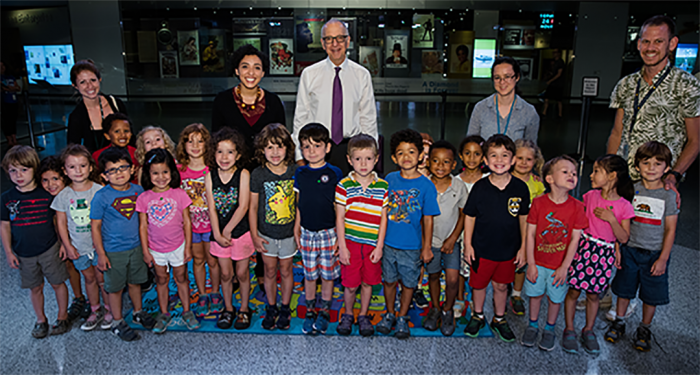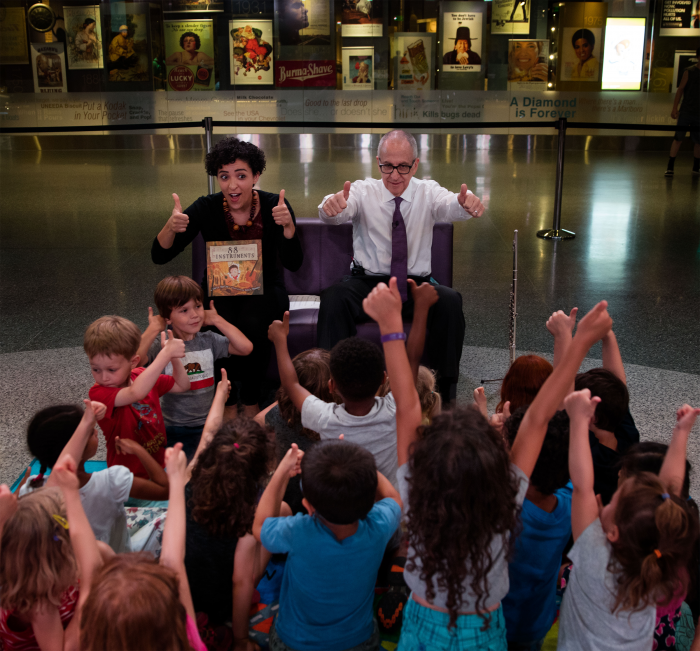These little bears are bullish about learning
Secretary Skorton recently had the chance to spend time with some of the Smithsonian’s littlest learners—and took away a few lessons himself.

The “Bears” class of four-year-olds at the Smithsonian’s Early Enrichment Center are getting a good start on a lifetime of joyful learning. Back row, from left, Jessie Miller, Lead Educator, Pre-K 4; Ariel Gory, NMAH Education Specialist; Smithsonian Secretary David Skorton; Phoebe Cos, Support Educator, Pre-K 4; and Will Kuehnle, Lead Educator, Pre-K 4. (Photo by Hugh Talman)
Although I love being Secretary of the Smithsonian, I sometimes miss students and teaching classes. I was thrilled, therefore, when education specialist Ariel Gory invited me to join her in presenting HiSTORYtime at the National Museum of American History on July 12. Our students—4-year-olds in the Bears class at Smithsonian Early Enrichment Center—reminded me how joyful learning can be, for educators and for students. The theme of the program was music and, after we all warmed up by dancing the hokey-pokey, Ariel read a book, 88 Instruments (written by Chris Barton and illustrated by Louis Thomas), and described an artifact: the Globe Trotter 8 Transistor Radio. Before breaking up into groups to make cardboard instruments, visit the American Enterprise exhibit, and tap out sound patterns, the students sang Twinkle, Twinkle, Little Star. I had the pleasure of accompanying them on the flute, assisted by Logan Belitsky, who enthusiastically—and expertly!—held my music.
For teaching about history, the sciences, culture and the arts, there are few environments more stimulating than museums, where artifacts, specimens, and works of art represent ideas, tell stories, provoke thinking and evoke feelings. The many educational programs we offer prove this point. On any given day, students in all age groups are gathered throughout our buildings, learning about things they’ll remember all their lives.

Logan Belitzsky is an enthusiastic assistant as Secretary Skorton leads the class in a rousing rendition of “Twinkle, Twinkle, Little Star.” (Photo by Hugh Talman)
Although the Smithsonian has followed James Smithson’s mandate—the increase and diffusion of knowledge—since our founding, we are constantly developing new ways to carry out his inspired and inspiring words. Along with the many options for tours and object-based programs, such as the Scavenger Hunt at the Postal Museum, Wildlife Tracking at the Zoo, and Design Field Trips at the Cooper-Hewitt Smithsonian Design Museum, we now have several dedicated educational facilities. The Q?rius center at the National Museum of Natural History enables students to use microscopes, solve puzzles, and handle objects; ARTLAB+ at the Hirschhorn Museum provides teens with professional technology equipment, tools, and materials to create their own art. Increasingly, we are presenting museum-based activities to students in remote locations—Artful Connections at the Smithsonian American Art Museum is one such program, the National Air and Space Museums STEM in 30 is another. All Smithsonian museums and research centers offer online activities and there are many digital resources, such as the Smithsonian Learning Lab and the Freer-Sackler Museum’s Cosmic Buddha program. There are also many resources and programs for teachers, such as the Science Education Center the National Museum of African American History and Culture race relations program, Let’s Talk.

Education Specialist Ariel Gory’s reading of “88 Instruments” gets a big thumbs-up from the class. (Photo by Hugh Talman)
If I haven’t mentioned an educational program in which you play a role, it’s because there are too many to list! Each and every tour and program we present is unique, expertly planned and executed, demonstrably effective and well loved by practitioners and students. As we move forward with our new strategic vision, we will continue to strengthen and increase our educational programs, and call more attention to them.
One of the most rewarding things about being Secretary is being able to visit so many Smithsonian locations, and observe visitors focusing on artifacts, studying scientific specimens, enjoying animals, viewing works of art . . . it delights me when that spark of recognition occurs, when it’s clear that a visitor has learned something new or become inspired in a positive way. It’s the reason I felt especially fortunate to be with Ariel and her colleagues to teach HiSTORYtime, and to see Logan and his Bear classmates as they learned about music. It’s what we’re all about.
Posted: 11 September 2017



